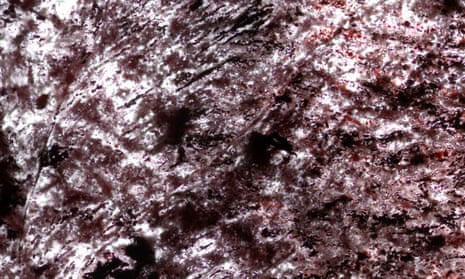Scientists believe they have found evidence of microbes that were thriving near hydrothermal vents on Earth’s surface just 300m years after the planet formed – the strongest evidence yet that life began far earlier than is widely assumed.
If confirmed, it would suggest the conditions necessary for the emergence of life are relatively basic.
“If life is relatively quick to emerge, given the right conditions, this increases the chance that life exists on other planets,” said Dominic Papineau, of University College London, who led the research.
Five years ago, Papineau and colleagues announced they had found microfossils in iron-rich sedimentary rocks from the Nuvvuagittuq supracrustal belt in Quebec, Canada. The team suggested that these tiny filaments, knobs and tubes of an iron oxide called haematite could have been made by bacteria living around hydrothermal vents that used iron-based chemical reactions to obtain their energy.
Scientific dating of the rocks has suggested they are at least 3.75bn years old, and possibly as old as 4.28bn years, the age of the volcanic rocks they are embedded in. Before this, the oldest reported microfossils dated to 3.46bn and 3.7bn years ago, potentially making the Canadian specimens the oldest direct evidence of life on Earth.
Now, further analysis of the rock has revealed a much larger and more complex structure – a stem with parallel branches on one side that is nearly a centimetre long – as well as hundreds of distorted spheres, or ellipsoids, alongside the tubes and filaments.
“One thing that I think is amazing is the sheer size of the tectonic branching structure, which is several millimetres, if not more than a centimetre in size,” said Papineau, adding that they bear some resemblance to filaments made by Mariprofundus ferrooxydans, a modern-day bacterium found in iron-rich deep sea environments, in particular hydrothermal vents. “But ours are much bigger, much thicker,” he said.
“I think what we are seeing is a microbial community – that they were working in concert and as the filaments grew from groups of these cells, they got intermingled and made a bigger, thicker haematite filament.
The team also identified mineralised chemical byproducts in the rock, consistent with these ancient microbes living off iron, sulphur and possibly also carbon dioxide and light through a form of oxygen-free photosynthesis.
Taken together, these new findings could suggest that a variety of microbial life may have existed as little as 300m years after Earth formed.
“I believe it makes sense that they are just as old as the volcanic rocks that embed them, which would be 4.28bn years,” Papineau said. “Pushing the clock back is very important, because it tells us that it takes a very short time for life to emerge on a planetary surface. Very quickly after [Earth formed] there was microbial life taking place, eating iron and sulphur in these hydrothermal vents.”
However, not everyone is convinced that the structures are biological in origin. While they bear some resemblance to other ancient and modern examples of bacteria, “these comparisons are in rocks or environments that have not been subjected to the very high degree of metamorphism [a process involving extreme temperature and pressure] of the Nuvvuagittuq rock”, said Prof Frances Westall, an expert on ancient fossil bacteria at the French National Centre for Scientific Research.
She said: “I am particularly concerned about the parallelism of the filaments – it looks as if they are following the crystal lattices of the host mineral. This is not a microbial feature, so the filaments could be a metamorphic artefact.”
On the other hand, the sulphur signature the team identified may have a biological origin. Westall said: “If their sulphur isotope data are correct, then it is possible that the chemical sediments represented by the Nuvvuagittuq jasperite did host traces of life associated with hydrothermal vents.”
